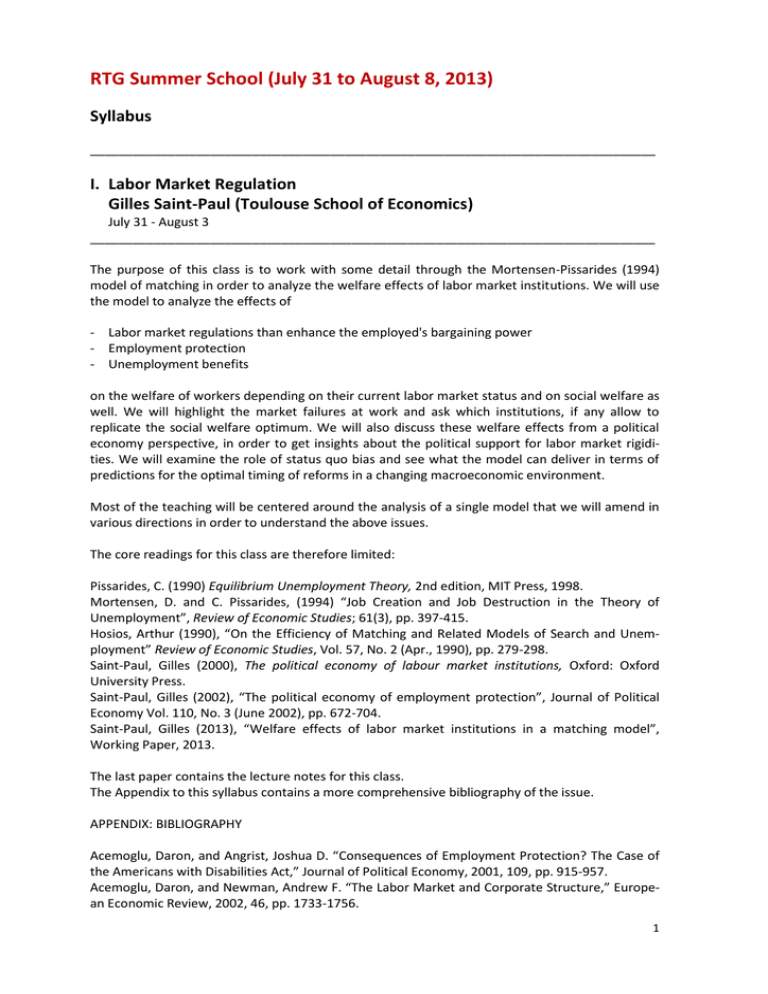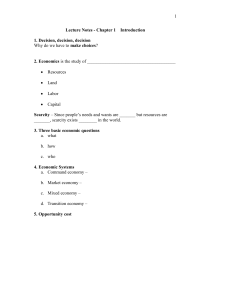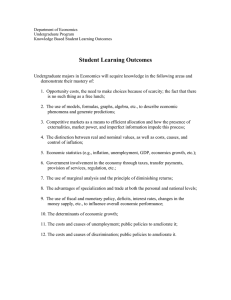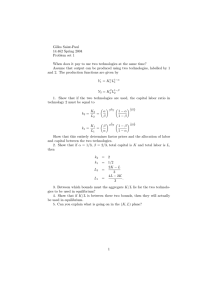RTG Summer School (July 31 to August 8, 2013)
advertisement

RTG Summer School (July 31 to August 8, 2013) Syllabus ________________________________________________________________________________ I. Labor Market Regulation Gilles Saint-Paul (Toulouse School of Economics) July 31 - August 3 ________________________________________________________________________________ The purpose of this class is to work with some detail through the Mortensen-Pissarides (1994) model of matching in order to analyze the welfare effects of labor market institutions. We will use the model to analyze the effects of - Labor market regulations than enhance the employed's bargaining power - Employment protection - Unemployment benefits on the welfare of workers depending on their current labor market status and on social welfare as well. We will highlight the market failures at work and ask which institutions, if any allow to replicate the social welfare optimum. We will also discuss these welfare effects from a political economy perspective, in order to get insights about the political support for labor market rigidities. We will examine the role of status quo bias and see what the model can deliver in terms of predictions for the optimal timing of reforms in a changing macroeconomic environment. Most of the teaching will be centered around the analysis of a single model that we will amend in various directions in order to understand the above issues. The core readings for this class are therefore limited: Pissarides, C. (1990) Equilibrium Unemployment Theory, 2nd edition, MIT Press, 1998. Mortensen, D. and C. Pissarides, (1994) “Job Creation and Job Destruction in the Theory of Unemployment”, Review of Economic Studies; 61(3), pp. 397-415. Hosios, Arthur (1990), “On the Efficiency of Matching and Related Models of Search and Unemployment” Review of Economic Studies, Vol. 57, No. 2 (Apr., 1990), pp. 279-298. Saint-Paul, Gilles (2000), The political economy of labour market institutions, Oxford: Oxford University Press. Saint-Paul, Gilles (2002), “The political economy of employment protection”, Journal of Political Economy Vol. 110, No. 3 (June 2002), pp. 672-704. Saint-Paul, Gilles (2013), “Welfare effects of labor market institutions in a matching model”, Working Paper, 2013. The last paper contains the lecture notes for this class. The Appendix to this syllabus contains a more comprehensive bibliography of the issue. APPENDIX: BIBLIOGRAPHY Acemoglu, Daron, and Angrist, Joshua D. “Consequences of Employment Protection? The Case of the Americans with Disabilities Act,” Journal of Political Economy, 2001, 109, pp. 915-957. Acemoglu, Daron, and Newman, Andrew F. “The Labor Market and Corporate Structure,” European Economic Review, 2002, 46, pp. 1733-1756. 1 Acemoglu, Daron and Robinson, James A. “Inefficient Redistribution,” American Political Science Review, 2001, 95, pp. 649-662. Acemoglu, Daron and James A. Robinson (2008) “Persistence of Power, Elites and Institutions,” American Economic Review, 98(1), pp. 267-93. Alesina, Alberto, Edward Glaeser, and Bruce Sacerdote (2005) “Work and Leisure in the U.S. and Europe: Why So Different?.” NBER Macroeconomic Annual: pp. 1-64. Alvarez, Fernando and Shimer, Robert. “Search and Rest Unemployment,” Econometrica, 2011, 79(1), pp. 75-122. Autor, David H., Kerr, William R. and Kugler, Adriana D. “Do Employment Protections Reduce Productivity? Evidence from US States,” The Economic Journal, 2007, 117, pp. 189-217. Autor, David H., Donohue III, John J. and Schwab, Stewart J. “The Costs of Wrongful-Discharge Laws,” Review of Economics and Statistics, 2006, 88(2), pp. 211-231. Bean, Charles. “The Interaction of Aggregate Demand Policies and Labor Market Reform,” Swedish Economic Policy Review, 1998, 5, pp. 353-88. Bénabou, Roland. “Unequal Societies: Income Distribution and the Social Contract,” American Economic Review, 2000, 90(1), pp. 96-129. Bentolila, Samuel and Bertola, Giuseppe. “Firing Costs and Labor Demand: How Bad is Eurosclerosis,” Review of Economic Studies, 1990, 57(3), pp. 381-402. Bentolila, Samuel and Dolado, Juan J. “Labour flexibility and wages: lessons from Spain,” Economic Policy, 1994, 14, pp. 53-99. Bentolila, Samuel, Dolado, Juan J. and Jimeno, Juan F. “Two-tier Employment Protection Reforms: The Spanish Experience,” CESIfo, Institute for Economic Research at the University of Munich, 2008, 6(4), pp. 49-56. Bentolila, Samuel, and Gilles Saint-Paul; “The Macroeconomic Impact of Flexible Labor contracts” European Economic Review, June 1992, 1013-1053. Bentolila, Samuel, and Gilles Saint-Paul; “A Model of Labour Demand with Linear Adjustment Costs” Labour Economics, 1,(1994), 303-326. Bertola, Giuseppe. “Job security, Employment, and Wages,” European Economic Review, 1990, 34(4), pp. 851-879. Bertola, Giuseppe. “Labor Turnover Costs and Average Labor Demand,” Journal of Labor Economics, 1992, 10(4), pp. 389-411. Bertola, Giuseppe. “Flexibility, Investment, and Growth,” Journal of Monetary Economics, 1994, 34(2), pp. 215-238. Bertola, Giuseppe and Ichino, Andrea. “Wage Inequality and Unemployment: United States versus Europe,” NBER Macroeconomics Annual, 1995, 10, pp. 13-66. Bertola, Giuseppe, and Richard Rogerson. “Institutions and Labor Reallocation.” European Economic Review, 1997, 41(6), pp. 1147-1171. Blanchard, Olivier. “Lionel Robbins Lectures,” The London School of Economics, 2000. Blanchard, Olivier and Giavazzi, Francesco. “The Macroeconomic Effects of Regulation and Deregulation in Goods and Labor Markets,” Quarterly Journal of Economics, 2003, 118(3), pp. 879-909. Blanchard, Olivier and Wolfers, Justin. “The Role of Shocks and Institutions in the Rise of European Unemployment: The Aggregate Evidence,” The Economic Journal, 2000, 110(462), pp. 1-33. Blanchard, Olivier and Portugal, Pedro. “What Hides Behind an Unemployment Rate: Comparing Portuguese and U.S. Labor Markets,” American Economic Review, 2001, 91(1), pp. 187-207. Boeri, Tito and Burda, Michael. “Preferences for Collective versus Individualised Wage Setting,” The Economic Journal, 2009, 119(540), pp. 1440-1463. Boeri, Tito, Conde-Ruiz, Ignacio J. and Galasso, Vincenzo. “The Political Economy of Flexicurity,” Journal of the European Economic Association, 2012, 10(4), pp. 684-715. Boeri, Tito and Garibaldi, Pietro. “Two Tier Reforms of Employment Protection Legislation. A Honeymoon Effect?,” The Economic Journal, 2007, 117(521), pp. 357-385. Bruegemann, Bjoern. “Does Employment Protection Create Its Own Political Support?,” Journal of the European Economic Association, 2012, 10(2), pp. 369-416. Bruegemann, Bjoern. “Employment protection: Tough to Scrap or Tough to Get?,” The Economic 2 Journal, 2007, 117(521), pp. 386-415. Caballero, Ricardo J. and Hammour, Mohamad L. “Jobless Growth: Appropriability, Factor Substitution, and Unemployment,” Carnagie-Rochester Conference Series on Public Policy, 1998, 48, pp. 51-94. Caballero, Ricardo J. “Specificity and the Macroeconomics of Restructuring,” 2007, Cambridge MA: The MIT Press. Cabrales, Antonio and Hopenhayn, Hugo A. “Labor Market Flexibility and Aggregate Employment Volatility,” Carnegie-Rochester Conference Series on Public Policy, 1997, 46(1), pp. 189-228. Cahuc, Pierre and Postel-Vinay, Fabien. “Temporary Jobs, Employment Protection and Labor Market Performance,” Labour Economics, 2002, 9(1), pp. 63-91. V. V. Chari, Restuccia, Diego and Urrutia, Carlos. “On-the-Job Training, Limited Commitment, and Firing Costs,” working paper, 2005. Coate, Stephen and Morris, Stephen. “Policy Persistence,” American Economic Review, 1999, 89, pp. 1327-1336. Di Tella, Rafael and MacCulloch, Robert. “The Consequences of Labor Market Flexibility: Panel Evidence Based on Survey Data,” European Economic Review, 2005, 49(5), pp. 1225-1259. Dolado, Juan J., Garcia-Serrano, Carlos and Jimeno, Juan F. “Drawing Lessons From The Boom of Temporary Jobs In Spain,” The Economic Journal, 2002, 112(721), pp. 270-295. 58[49] Fernandez, Raquel and Rodrik, Dani. “Resistance to Reform: Status Quo Bias in the Presence of Individual-Specific Uncertainty,” American Economic Review, 1991, 81, pp. 1146-55. Garibaldi, Pietro and Violante, Gianluca. “The Employment Effects of Severance Payments With Wage Rigidities,” The Economic Journal, 2005, 115, pp. 799-832. Giersch, Herbert. “Eurosclerosis,” Kiel Discussion Papers No. 112, Inst. für Weltwirtschaft, 1985. Guell, Maya. “Firing Costs, Dismissal Conflicts and Labour Market Outcome,” CREI, 2010. Hassler, John, and Mora, José V. “Employment Turnover and the Public Allocation of Unemployment Insurance,” Journal of Public Economics, 1999, 3(1), pp. 55-84. Hassler, John, Mora, José V., Storlesseten, Kjetil and Zilibotti, Fabrizio. “Survival of the Welfare State,” American Economic Review, 2003, 93, pp. 87-112. Hopenhayn, Hugo and Rogerson, Richard. “Job Turnover and Policy Evaluation: A General Equilibrium Analysis,” Journal of Political Economy, 1993, 101(5), pp. 915-938. Kugler, Adriana D. “The Impact of Firing Costs on Turnover and Unemployment: Evidence from the Colombian Labour Market Reform,” International Tax and Public Finance, 1999, 6, pp. 389-410. Kugler, Adriana D. “Wage-Shifting Effects of Severance Payments Savings Accounts in Colombia,” Journal of Public Economics, 2005, 89, pp. 487-500. Kugler, Adriana D., Jimeno, Juan F. and Hernanz, Virginia. “Employment Consequences of Restrictive Permanent Contracts: Evidence from Spanish Labor Market Reforms,” CEPR Discussion Paper No. 3724, 2003. Kugler, Adriana D., and Pica, Giovanni. “Effects of Employment Protection and Product Market Regulations on the Italian Labor Market,” CEPR Discussion Paper No. 4216, 2004. Kugler, Adriana and G. Saint-Paul, “How do firing costs affect labor market flows in a model with adverse selection?” Journal of Labor Economics, 22, 3, 2004, pp. 553-584. Lazear, Edward P. “Job Security Provisions and Employment,” Quarterly Journal of Economics, 1990, 105, pp. 699-726. Larsen, Flemming. “The importance of Institutional Regimes for Active Labour Market Policies – The Case of Denmark,” Danish National Centre for Labour Market Research (CARMA), 2004. Ljungqvist, Lars and Sargent, Thomas J. “The European Unemployment Dilemma,” Journal of Political Economy, 1998, 106, pp. 514-550. Mortensen, Dale and Pissarides, Christopher. “Job Creation and Job Destruction in the Theory of Unemployment,” Review of Economic Studies, 1994, 61, pp. 397-415. Oyer, Paul and Schaefer, Scott. “Layoffs and Litigation,” RAND Journal of Economics, 2000, 31, pp. 345-58. Oyer, Paul, and Schaefer, Scott. “Litigation Costs and Returns to Experience,” American Economic Review, 2002, 92, pp. 683-705. 3 Pissarides, Christopher A. “Equilibrium Unemployment Theory,” Cambridge MA: MIT Press, 2000. Pries, Michael and Richard Rogerson. “Hiring Policies, Labor Market Institutions, and Labor Market Flows,” Journal of Political Economy, 2005, 113, pp. 811-839. Saint-Paul, Gilles. “On the Political Economy of Labor Market Flexibility,” NBER Macroeconomics Annual, 1993, pp. 151-95. Saint-Paul, Gilles. “Exploring the Political Economy of Labor Market Institutions,” Economic Policy: A European Forum, 1996, 23, pp. 263-300. Saint-Paul, Gilles. “The Political Economy of Labor Market Institutions,” New York, NY: Oxford University Press, 2000. Saint-Paul, Gilles. “The Political Economy of Employment Protection,” Journal of Political Economy, 2002, 110(3), pp. 672-704. Shapiro, Carl and Stiglitz, Joseph E. “Equilibrium Unemployment as a Worker Discipline Device,” American Economic Review, 1984, 74(3), pp. 433-44. Vindigni, Andrea. “Uncertainty and the Politics of Employment Protection,” PrincetonUniversity Working Paper, Industrial Relations Section No. 465, 2002. Yashiv, Eran. “The Determinants of Equilibrium Unemployment,” American Economic Review, 2000, 90(5), pp. 1297-1322. _______________________________________________________________________________ II. Product Market Regulation: Frontiers in the Theory of Competition Policy Volker Nocke (University of Mannheim) nocke@uni-- mannheim.de August 5-8 _________________________________________________________________________ Reading List 1. Horizontal Merger Policy • Compte, Olivier, Frederic Jenny and Patrick Rey (2002). Capacity Constraints, Mergers and Collusion, European Economic Review, vol. 46(1), 1-29. • Farrell, Joe and Carl Shapiro (1990). Horizontal Mergers: An Equilibrium Analysis, American Economic Review, vol. 80(1), 107-126. • Nocke, Volker and Michael D. Whinston (2010). Dynamic Merger Review, Journal of Political Economy, vol. 118(6), 1200-1251. • Nocke, Volker and Michael D. Whinston (2013). Merger Policy with Merger Choice, American Economic Review, vol. 103(2), 1006-1033. 2. Vertical Relations • Aghion, Philippe and Patrick Bolton (1987). Contracts as a Barrier to Entry, American Economic Review, vol. 77(3), 388-401. • Bernheim, B. Douglas and Michael D. Whinston (1998). Exclusive Dealing, Journal of Political Economy, vol. 106(1), 64-103. • Chen, Yongmin (2001). On Vertical Mergers and their Competitive Effects, Rand Journal of Economics, vol. 38, 2-21. • Hart, Oliver and Jean Tirole (1990). Vertical Integration and Market Foreclosure, Brookings Papers on Economic Activity. Microeconomics, 205-286. • Hombert, Johan, Jerome Pouyet, and Nicolas Schutz (2013). Anticompetitive Vertical Merger Waves, Mimeo. • Nocke, Volker and Lucy White (2007). Do Vertical Mergers Facilitate Upstream Collusion? American Economic Review, vol. 97(4), 1321-1339. 4 • Ordover, Janusz A., Gareth Saloner and Steven C. Salop (1990). Equilibrium Vertical Foreclosure, American Economic Review, vol. 80(1), 127-142. • Rasmusen, Eric B., J. Mark Ramseyer and John S. Wiley (1991). Naked Exclusion, American Economic Review, vol. 81(5), 1137-1145. • Rey, Patrick and Jean Tirole (2007). A Primer on Foreclosure, in: Armstrong, Mark and Robert H. Porter (eds.), Handbook of Industrial Organization, vol. 3, North Holland. • Segal, Ilya R. (1999). Contracting with Externalities, Quarterly Journal of Economics, vol. 114(2), 337-388. • Segal, Ilya R. and Michael D. Whinston (2000). Naked Exclusion: Comment, American Economic Review, vol. 90(1), 296-309. 3. Collusion and Leniency Policy • Harrington, Joseph E., Jr. (2008). Optimal Corporate Leniency Programs, Journal of Industrial Economics, vol. 56(2), 215-246. • Harrington, Joseph E., Jr. (2013). Corporate Leniency Programs when Firms have Private Information: The Push of Prosecution and the Pull of Pre-Emption, Journal of Industrial Economics, vol. 61(1), 1-27. • Harrington, Joseph E., Jr. and Myong-Hun Chang (2009). Modelling the Birth and Death of Cartels with an Application to Evaluating Antitrust Policy, Journal of the European Economic Association, vol. 7(6), 1400-1435. • Motta, Massimo and Michele Polo (2003). Leniency Programs and Cartel Prosecution, International Journal of Industrial Organization, vol. 21(3), 347-379. • Spagnolo, Giancarlo (2008). Leniency and Whistleblowers in Antitrust, in: Handbook of Antitrust Economics, Paolo Bucirossi, ed., Cambridge, Mass.: MIT Press. 5




